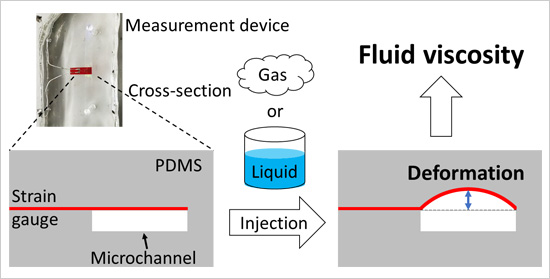Development of a Viscosity Measurement Technique Applicable to Both Liquids and Gases
2021.06.14
National Institute for Materials Science (NIMS)
NIMS and Harvard University jointly developed a technique capable of measuring the viscosity of both liquids and gases using the same device.
Abstract
- NIMS and Harvard University jointly developed a technique capable of measuring the viscosity of both liquids and gases using the same device. This device can be used to identify unknown fluids based on their viscosities and may potentially be used to analyze biological fluids (e.g., breath and blood) for health monitoring and medical checkups. The device may also be used to investigate the physical properties and phase transitions of liquid/gas mixtures in basic research.
- Liquids vary in viscosity, and we see the difference in our daily lives. For example, honey is very viscous while water is less viscous. However, viscosity is not an only characteristic unique to liquids; gases also have viscosities. Because any fluid including both liquids and gases has its inherent viscosity, techniques for measuring them are very important for scientific community and industry. Various types of viscometers are already available commercially and are commonly used to measure liquids, while techniques of measuring gaseous viscosity are still being researched. Accordingly, no method capable of measuring the viscosity of both liquids and gases—two fundamentally different fluid phases—is available. Interest has been growing in recent years in connection with the development of compact and simple technologies capable of measuring and identifying both liquids and gases, including wearable blood pressure meters and portable odor sensors. It is therefore desirable to develop a new viscosity measurement technique compatible with a broader range of fluids.
- This research team recently fabricated a device made of a soft material called polydimethylsiloxane (PDMS) with an internal cavity (the microchannel in the figure) into which a fluid sample can be injected. A commercially available strain gauge was embedded just above and across the microchannel. When an injected fluid passes through the microchannel, it is deformed and thus the deformation is detected by the strain gauge. The team found that the extent of the deformation correlates with the viscosity of the injected fluid for both liquids and gases. Using this correlative relationship, this simple device is able to measure the viscosity of any fluid in real time with high sensitivity.
- In future research, we plan to measure the viscosity of various biological fluids (e.g., human breath and other biological gases, saliva, urine and blood) to assess the usability of this device for analyzing and identifying them. We envision health monitoring and medical checkup applications using this device. In addition, we are considering a basic research application for this device; it could be used to measure the viscosity of fluids even during phase transition from gas to liquid and vice versa and the viscosity of liquid/gas two phases in various forms such as bubble flow, slug flow, annular flow, and so on.
- This project was carried out by a research team led by Kota Shiba (Senior Researcher, Olfactory Sensors Group, Research Center for Functional Materials, NIMS) and David A. Weitz (Professor, Harvard University). This work was supported by the Fostering Joint International Research (B) category of the JSPS Grant-in-Aid for Scientific Research (grant number: JP19KK0141), the long-term overseas research fund from the Telecommunications Advancement Foundation and an exchange research grant from the Marubun Research Promotion Foundation.
- This research was published in the online version of Lab on a Chip on June 9, 2021, local time. Our provisional patent application has been accepted by the US Patent and Trademark Office (application number: 63/195894).

Figure. Schematic of the viscosity measurement process using the new technique.
Related files
- Research Center for Functional Materials
Contact information
(Regarding this research)
-
Kota Shiba
Senior Researcher
Olfactory Sensors Group
Research Center for Functional Materials
National Institute for Materials Science
Tel: +81-29-860-4603
E-Mail: SHIBA.Kota=nims.go.jp
(Please change "=" to "@")
(General information)
-
Public Relations Office
National Institute for Materials Science
Tel: +81-29-859-2026
Fax: +81-29-859-2017
E-Mail: pressrelease=ml.nims.go.jp
(Please change "=" to "@")
Recent Press Release
-
Simultaneous Imaging of Intracellular DNA and RNA Using Harmless Light
2025.10.27
-
Development of an AI Device Using Ion Gel and Graphene That Dramatically Streamlines Machine Learning Computations
2025.10.14
-
Demonstrating a Novel Method to Modulate Heat Flow Through the Collective Motion of Spins
2025.10.06
